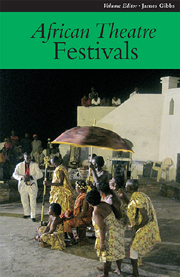Book contents
- Frontmatter
- Contents
- Notes on Contributors
- Obituary of Efo Kodjo Mawugbe
- Introduction by James Gibbs
- Festivals as a Strategy for the Development of Theatre in Zimbabwe 1980–2010
- The Legacy of Festac '77
- Festac, Month by Month & Soyinka's Involvement
- The Dakar Festivals of 1966 & 2010
- African Renaissance between Rhetoric 30 & the Aesthetics of Extravagance FESMAN 2010 – Entrapped in Textuality
- Theatre Programme for FESMAN & Commentary
- The Pan-African Historical Theatre Festival (PANAFEST) in Ghana, 1992–2010
- PANAFEST through the Headlines
- International Festivals & Transnational Theatre Circuits in Egypt, 1988–2010
- The Jos Theatre Festival 2004–2011
- The Grahamstown Festival & the Making of a Dramatist An interview with ANDREW BUCKLAND
- Playscript
- Book Reviews
African Renaissance between Rhetoric 30 & the Aesthetics of Extravagance FESMAN 2010 – Entrapped in Textuality
Published online by Cambridge University Press: 05 May 2013
- Frontmatter
- Contents
- Notes on Contributors
- Obituary of Efo Kodjo Mawugbe
- Introduction by James Gibbs
- Festivals as a Strategy for the Development of Theatre in Zimbabwe 1980–2010
- The Legacy of Festac '77
- Festac, Month by Month & Soyinka's Involvement
- The Dakar Festivals of 1966 & 2010
- African Renaissance between Rhetoric 30 & the Aesthetics of Extravagance FESMAN 2010 – Entrapped in Textuality
- Theatre Programme for FESMAN & Commentary
- The Pan-African Historical Theatre Festival (PANAFEST) in Ghana, 1992–2010
- PANAFEST through the Headlines
- International Festivals & Transnational Theatre Circuits in Egypt, 1988–2010
- The Jos Theatre Festival 2004–2011
- The Grahamstown Festival & the Making of a Dramatist An interview with ANDREW BUCKLAND
- Playscript
- Book Reviews
Summary
The Third Festival of Black Arts (FESMAN) held between December 10 and 31, 2010, was announced as heralding a Renaissance of Africa and its Diaspora, through an aesthetic embrace and a celebration of its creativity and its diverse identity. It was a projective extension of a vast programme of revival and unity encompassed in the ambitious New Partnership for African Development (NEPAD) initiative. President Abdoulaye Wade, initiator of the festival, was one of the proponents of NEPAD, along with Olusegun Obasanjo (Nigeria), Thabo Mbeki (South Africa) and Abdelaziz Bouteflika (Algeria). However, Wade's brand of renaissance is a product of delirium. It is a one-man show ripped out of the temporal frame of the African revival movement that enjoins moderation, lucidity and self-restraint as a sign of and in the service of progress. Wade's brand of renaissance is a belaboured concept emptied of its essence, and laid bare in its superfluity: a form of renaissance as posture which departs in so many ways from African Renaissance as praxis.
But we have to look beyond Wade's tendencies and tastes for extravaganza, and his desperate, reductivist attempts to leave his name to posterity.
- Type
- Chapter
- Information
- African Theatre 11: Festivals , pp. 30 - 38Publisher: Boydell & BrewerPrint publication year: 2012



